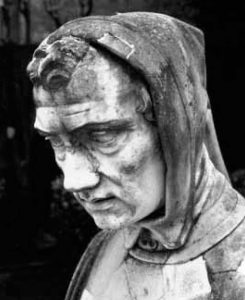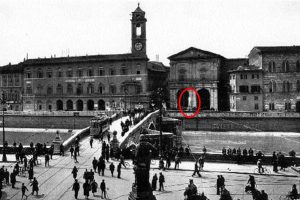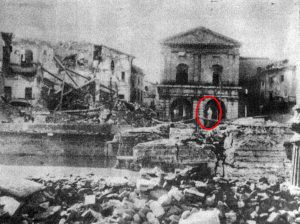 The statue of Fibonacci in the Camposanto Monumentale annexed to the cathedral and the famous leaning tower of Pisa has a face that is more meditative than pensive; the dark circles under the eyes and the tense rictus hint at a suspicion of concentrated suffering. The statue is not contemporary with Leonardo of Pisa, the famous 13th century merchant and mathematician to whom the spread of Hindu-Arabic numerals throughout Europe owes so much, but seven centuries later, and his face is not Fibonacci’s face, because there is no historical record of what it looked like. The statue is the work of the Florentine sculptor Giovanni Paganucci and was erected in 1863 in the old Pisan cemetery. The sculpture’s face shows the scars of an eventful life, although the cruelty of that destiny is perhaps best portrayed in the sculpture’s hands, both of them with their fingers mutilated.
The statue of Fibonacci in the Camposanto Monumentale annexed to the cathedral and the famous leaning tower of Pisa has a face that is more meditative than pensive; the dark circles under the eyes and the tense rictus hint at a suspicion of concentrated suffering. The statue is not contemporary with Leonardo of Pisa, the famous 13th century merchant and mathematician to whom the spread of Hindu-Arabic numerals throughout Europe owes so much, but seven centuries later, and his face is not Fibonacci’s face, because there is no historical record of what it looked like. The statue is the work of the Florentine sculptor Giovanni Paganucci and was erected in 1863 in the old Pisan cemetery. The sculpture’s face shows the scars of an eventful life, although the cruelty of that destiny is perhaps best portrayed in the sculpture’s hands, both of them with their fingers mutilated.

The statue of Leonardo de Pisa, that statue which does not bear Fibonacci’s forgotten features on its face, bears instead all the pain that the wars of the 20th century in Europe were capable of inflicting even on statues.
Fibonacci’s statue was moved in 1926 from the cemetery to a central location in Pisa by Mussolini’s co-religionists (right photo); on the pedestal they added a phrase: “From Oblivion to Glory by the Fascist Will”.
This place was almost turned to rubble when in 1944 the Allied troops liberated Pisa from the Germans (left photo). The statue, although damaged, managed to survive; witnessing death and destruction from its podium, perhaps it was then that the rictus of concentrated pain was marked on its features and when the deep sadness that crosses its face emerged from its stony entrails.
The statue of Leonardo de Pisa, the one that never bore Fibonacci’s lost physiognomy on its face, was then forgotten in a municipal depot and underwent several surgical repairs, before returning to the quiet silence of the cemetery.
Bibliography
Antonio J. Durán, Vida de los números, T Ediciones, Madrid, 2006.


Leonardo de Pisa es y será recordado por su grandes aportes a la ciencia. Saludos